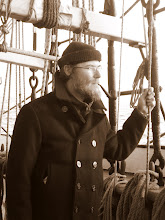A possible source for Jules Verne's Nautilus.
Found this article at the fantastic Vernian Era website. I have previously discussed another set of pages from this site in my School of Nautili post. Michael Crisafulli has collected some wondeful information on various technologies that existed at the time Jules Verne was writing. Many of these were experimental and considered unworkable but they could easily have been used as inspiration by Verne.
A good example of such a technology was the Cigar Ships that the Winans Family of Baltimore, Maryland, built between 1858 and 1866.
he cigar ships were designed and built by the Winans family, successful railway engineers from Baltimore, Maryland who moved into marine engineering with enthusiasm and great expenditures of their family wealth, but less success. Their radical marine design concept included an ultra-streamlined spindle-shaped hull with minimum superstructure.
The Winans constructed at least four ships between 1858 and 1866. Two of these attracted considerable public attention as well as skepticism and outright criticism from the technical establishment. Ross Winans and his sons were, first and foremost, engineers experimenting with innovative concepts. The innovative technology would certainly have attracted Jules Verne's attention. He may well have seen one of the boats sailing or berthed in England. Some of their innovations were adopted for surface ships in the twentieth century, and many of the pioneer submarines built in the late nineteenth and early twentieth century resembled them. Later in the twentieth century, aerodynamicists rediscovered the benefits of the spindle.
The site discusses the history of these odd vessels and many of the design problems that the Winans had to overcome.
The final ship built using this design was the yacht Ross Winans built in 1866.
From the website:
The Winans launched their final effort in 1866 in London. The Ross Winans was 256 feet long with the same 16-foot diameter as their first boat and displaced about 400 tons. It did have a nearly conventional superstructure atop the hull amidships, 130 feet long and ten feet wide, tapering to a point at each end. Inverting the first design, it was driven by a 22-foot diameter propeller at each end. These nine-bladed props were powered by an engine room amidships. The Ross Winans underwent trials in the Solent channel but made no more than one or two coastal voyages, never going to sea in earnest.
The woodcut at right, from The Illustrated London News, 3 Mar
1866, shows the stern-first launching of the Ross Winans. The
propeller mounts are visible, but the propellers have not yet been
installed.
|
 |
Highly recommended reading this!
Check out the full article at: The Winans Cigar Ships
Keep your sightglass full, your firebox trimmed and your water iced.
KJ




~ 0 comments: ~
~ Post a Comment ~